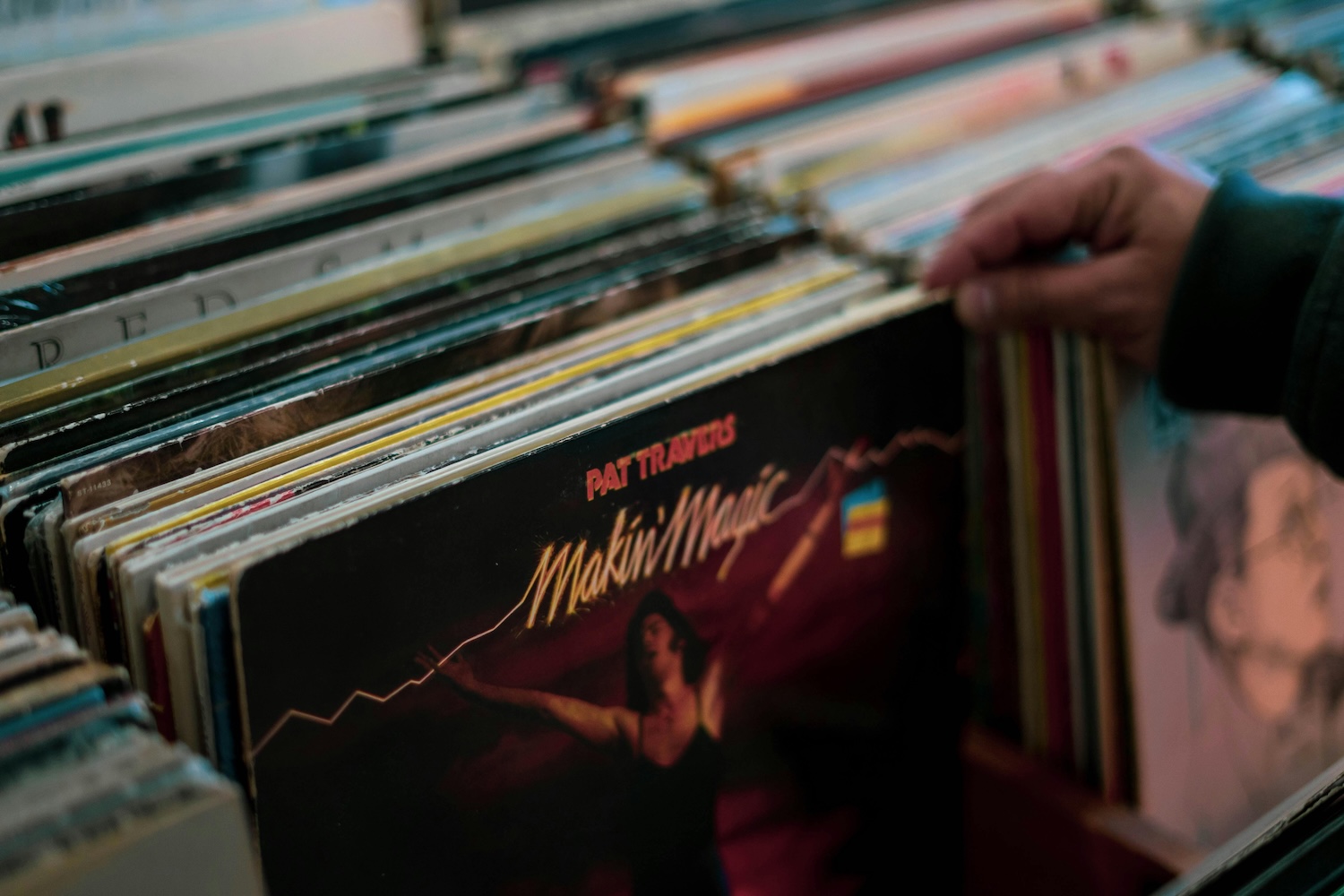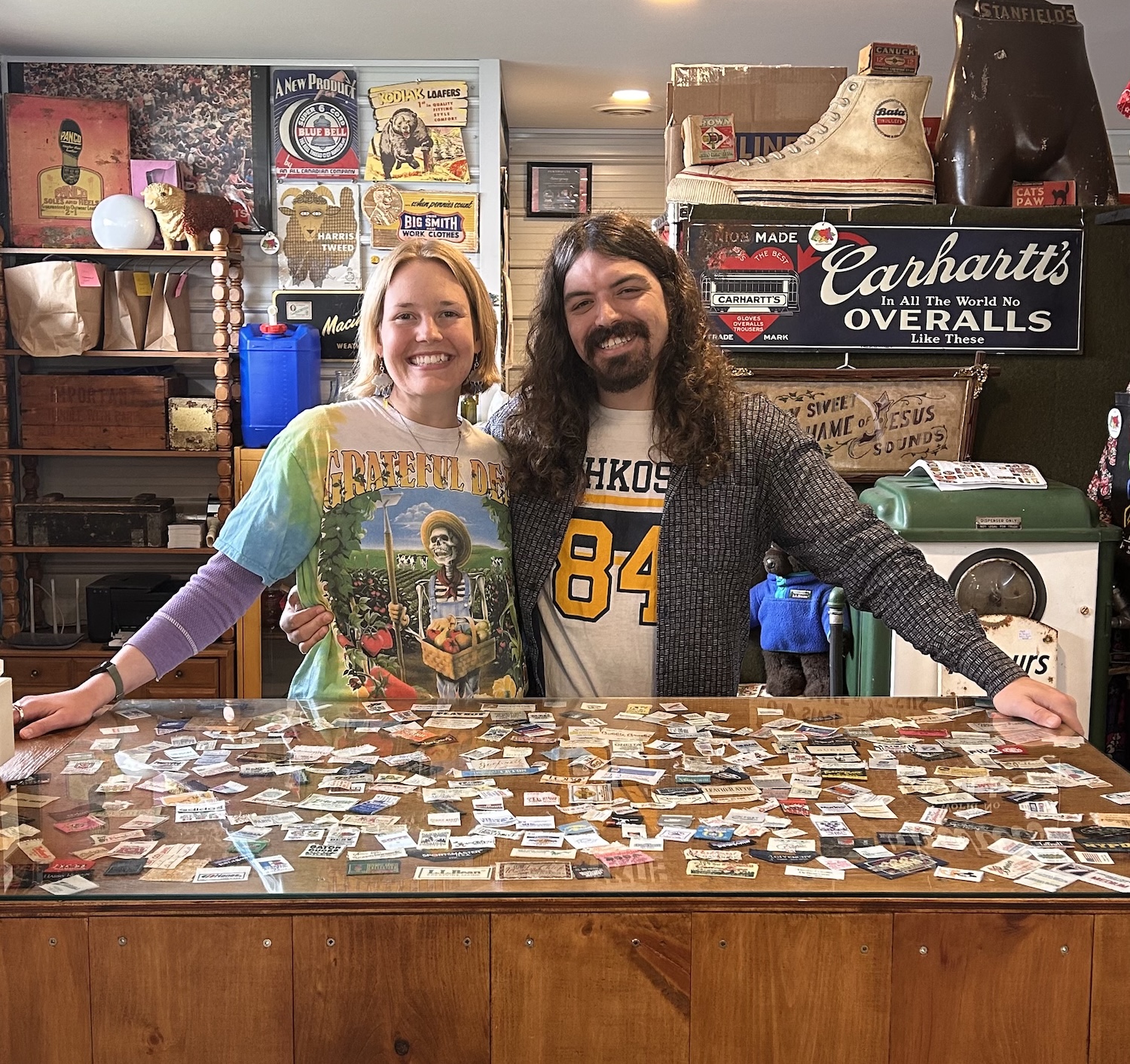
Atomic appeal: Good as Old shines social spotlight on mid-century modern furniture and decor
How a vintage-reselling, serial-collecting couple carved out a social media space for their side hustle
For Kaitlyn and Frazer, owners of vintage shop Good as Old, a vintage blow mold from the 1990s set off a holiday decor collection that would put Clark Griswold to shame.
Vintage blow molds — those hollow plastic characters you see livening up front lawns around the major holidays — are having a renaissance and, for some collectors, are harder to source than ever.
But Kaitlyn and Frazer have a knack for finding the yard decorations and count hundreds of blow molds in their collection, including an assortment themed for Halloween and Christmas. In September and November, the couple release the holiday blow molds from captivity and set them all over their 30-acre farm.
The blow molds are seasonally sorted and housed year-round on the upper level of a climate-controlled workshop on their property, which also houses most of the vintage furniture they sell for Good as Old.
“When we started building the blow mold collection, we thought, ‘Maybe we can resell them,” says Kaitlyn. “But then you meet the blow molds and you’re like, ‘I’m going to keep every single one of you. I will build a house for you!’”
“That’s how a couple of our collections started — I’d think, ‘This is such a savvy business decision.’ And then it’s just like, I love everything.”
Collecting has become a sport for the couple. Among their other collections are more than eight 1950s-era aluminum trees and eight atomic terrariums.
“When people say something is really hard to find, I just become really interested and find it,” Kaitlyn says. “I wouldn’t say I’m manifesting. I search hard looking for those things!”

Sticking to a niche
Nearly four years ago, a shared love of researching and collecting led Kaitlyn and Frazer to the idea of selling vintage furniture as a hobby — Kaitlyn’s a college instructor and Frazer is a heavy truck mechanic.
“You find a few things you really like and then as you explore that more, you realize how much more cool stuff there is out there,” says Frazer. “It takes you down this rabbit hole.”
The couple started selling under Good as Old on Facebook Marketplace and managed a booth at an antique mall for a while, but now sell exclusively on Instagram by hosting regular product drops on their feed and on Stories.
With vintage furniture, they’ve carved out a niche and a business model that works for their part-time commitment, offering delivery on certain days of the month.

While they sometimes move small decor items, Kaitlyn and Frazer are located in Roseneath, Ont. (about an hour and 40 minutes drive northeast of Toronto) and furniture is what gives them the best return on their time and cost investment.
Aside from social media, which Kaitlyn handles, the couple shares responsibilities for the business, from sourcing and pickups to staging and deliveries, as a way to spend time with one another.
They clean, oil and sometimes strip pieces, and do minor repairs and replacements as needed, but are proponents of letting a piece’s character shine through, both from a vintage-loving perspective and a business model perspective.
“If there's a chip in the veneer, we just disclose it,” Frazer says. “We try not to actually buy anything that needs a ton of work because we don’t have time to put a whole day into a piece.”

Preserving stories
Scroll through Good as Old’s midcentury-heavy Instagram feed and you get an immediate sense of the couple’s style, and by extension their personalities: Atomic Age–era coffee tables share space with tulip lamps, Danish-made walnut dressers with classic tapered legs, Cesca-style chairs. They love cool and unusual shapes and playful colours.
“We’re big kids,” laughs Kaitlyn. One of the centrepieces in their home is a working, 14-foot-long vintage Skee-Ball machine that they drove to Quebec to get — a 10-plus-hour return trip.
When Kaitlyn and Frazer learned a 12-foot Adrian Pearsall sofa complete with teak corners and a back console table was due to be thrown in the garbage, they picked it up, reupholstered it and placed it in their living room.
“When we buy things for ourselves, or to sell, there’s always a story behind a piece,” says Kaitlyn. “Like, ‘This was my dad's favourite couch’ or ‘We’ve always had dinner here and you can see where as a kid, I would kick the legs.’”
“We also get to make our own stories when we pick things up. Like when we drove all the way to Quebec for one day and drove all the way back. We have a different story now to add to that piece. It has a lot more meaning to it.”
They once picked up a table that featured stickers of Donny and Marie Osmond on the underside, courtesy of the owner who had decorated it as a child.
Purchasing a vintage item with that kind of story attached to it gives memories the chance to live on, says Kaitlyn. “You have someone’s life underneath your feet at your kitchen table.”
Continued below
Join our vendor network
Become a member
Continued from above
Ensuring value for money
One of the stories that today’s consumer adds to the chronology of vintage furniture is a deep desire for sustainability that increasingly drives purchase decisions.
“We have a much more conscious generation that looks at older pieces they can reuse,” says Kaitlyn. “Younger generations don’t want shoebox things. They don’t want to do zero financing and go to The Brick and get a bunch of stuff.”
Young people are embracing the quality of old pieces too. The couple hopes that more shoppers embrace the value and longevity that good vintage furniture has, especially in a fast-furniture landscape where much of today’s affordable furniture isn’t built to last.
“Somebody might not have to buy a piece of furniture three times and throw it out three times because they have that better piece,” says Frazer. “We’ve talked to people who buy a new couch every five years and it’s like, why? The vintage furniture people buy from us or that they buy from other people — they’re going to use that for as long as they can.”
Selling such well-made furniture that won’t need to be replaced for a long time comes with a trade off — a finite amount of purchases for repeat customers. Kaitlyn jokingly wonders if Good as Old is cannibalizing their corner of the market. “Will there be enough people that will buy all of this?’” she laughs.

Establishing policies
Kaitlyn and Frazer don’t have a lot to worry about for the moment as the consumer market continues to grow. They’re up to 12,000-plus followers on their Instagram account, frequently selling items as quickly as they’re posted.
While there are overall less vendors dealing in vintage furniture than vintage fashion or vintage decor, the market can be competitive when it comes to sourcing.
“Customers are not necessarily going to thrift stores to find these things. They’re the ones fighting with you on Marketplace trying to grab that piece,” says Kaitlyn. “We don’t want to start bidding wars. The idea behind our business is to save those pieces from landfill.”
Online etiquette has changed in recent years, which in turn has limited how much sourcing resellers do on what were once go-to platforms such as Facebook Marketplace, Kaitlyn says.
On the buyer side, occasionally customers are upset if they’re not first in line to snag the piece they’re after. And on the seller side, the couple has experienced sellers sending full deposits back after deciding to take another offer, or scheduling pickups and then ghosting. Now, their sourcing strategy relies less on social media listings.
“The disappointing ones are the ones that help you build your shop policies,” says Kaitlyn. “You start to realize that you are your business. A lot of the times, when people have full access to you [like on social media], you need to set those boundaries. You’re not being rude. You're setting professional boundaries so that people can respect how you run your shop, like whether or not you're going to be doing pre-sales, or if you’re doing returns.”
For example, in lieu of returns, Good as Old customers can visit in-person to view a piece they’re unsure about, or request videos and close-ups of imperfections.
“At the end of the day, it’s not about just getting rid of a piece, it’s about rehoming it,” Kaitlyn says. “We want to make sure whoever’s getting it isn't going to be like, ‘Oh, I absolutely hate this, why would you make me buy it?’ We want to show you everything so that you’re happy with it.”

Building a social media community
Most of the couple’s online-selling experiences have been overwhelmingly positive, they say. Kaitlyn and Frazer routinely connect with other dealers to sell and to make trades.
Both maintain there’s room for everyone, even with an increased number of vendors starting up shops during the pandemic. “People aren’t your competition,” Frazer says. “There’s enough stuff to go around.”
The pair are community builders, too, helping to amplify the reach of other sellers in their region. Having started their selling careers in the Hamilton area, Good as Old is still a fixture of the Hamilton Vintage Community, an Instagram-based social media page that reposts content from vendors in the Hamilton, Cambridge and Niagara regions to its 16,000-plus audience. Kaitlyn is one of the group’s admins and, as Good as Old, also hosts monthly virtual markets featuring a rotating roster of vendors.
“Supporting everyone, regardless of what they're selling, even if it’s the same as us, shows we’re leading by example,” says Kaitlyn. “This is supposed to be fun. Yes, it’s important to make money, but it is not supposed to take from you.”

Boosting the sellers behind the shops
The vintage furniture market can be hard to break into, but Kaitlyn and Frazer are happy with the connections they’ve made in the community and the schedule they’ve built that allows them to work at their jobs, sell vintage on the side, take care of their property, farm their land and rehabilitate their four rescue donkeys.
The animal lovers are working toward turning their farm into a donkey sanctuary.
They say they’re grateful for how the pandemic shone a light on the secondhand-goods market, which is encouraging people who may not have previously considered vintage to explore what’s available.
“We’ve had people in their 50s and 60s come to us to buy stuff they remember their parents having,” says Frazer. “They’ve had other furniture till now, but they’re going back to the stuff their parents had.”
The heightened focus on the resale market has led to more scrutiny about the practice of reselling, too, with critics questioning the supply-and-demand system and the ethics of buying cheap and selling high, despite both being common models in the firsthand retail marketplace.
Kaitlyn says she hopes to see more value placed on the sustainability of the venture, as well as on the folks who are behind the shops.
“There are always different reasons why people do it. You need to look a little past the idea that people are making money selling things that they're buying secondhand,” she says.
“People are making a living or they are helping themselves get a little bit further in what they're wanting to do with their lives. For us, we’re fixing up a really old house and we’re trying to rescue all the donkeys!”
Thank you for valuing our work!
Support our work to see this page.
You’ve got a good eye, but this gem is only available for members. Register for a plan or upgrade your current one to peek behind this vintage curtain, or log in below.















